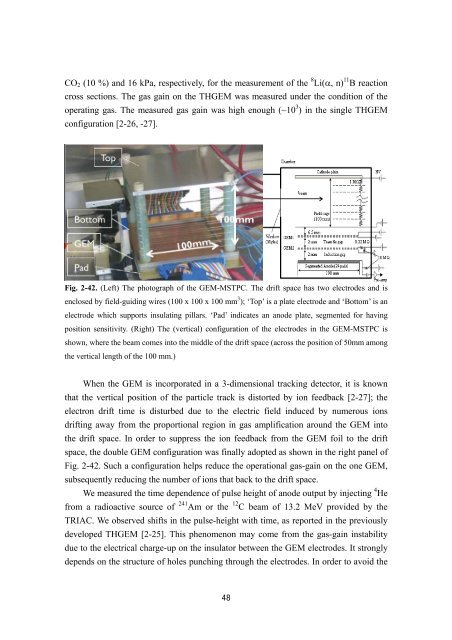TRIAC Progress Report - KEK
TRIAC Progress Report - KEK
TRIAC Progress Report - KEK
Create successful ePaper yourself
Turn your PDF publications into a flip-book with our unique Google optimized e-Paper software.
CO2 (10 %) and 16 kPa, respectively, for the measurement of the 8 Li(α, n) 11 B reaction<br />
cross sections. The gas gain on the THGEM was measured under the condition of the<br />
operating gas. The measured gas gain was high enough (~10 3 ) in the single THGEM<br />
configuration [2-26, -27].<br />
Fig. 2-42. (Left) The photograph of the GEM-MSTPC. The drift space has two electrodes and is<br />
enclosed by field-guiding wires (100 x 100 x 100 mm 3 ); ‘Top’ is a plate electrode and ‘Bottom’ is an<br />
electrode which supports insulating pillars. ‘Pad’ indicates an anode plate, segmented for having<br />
position sensitivity. (Right) The (vertical) configuration of the electrodes in the GEM-MSTPC is<br />
shown, where the beam comes into the middle of the drift space (across the position of 50mm among<br />
the vertical length of the 100 mm.)<br />
When the GEM is incorporated in a 3-dimensional tracking detector, it is known<br />
that the vertical position of the particle track is distorted by ion feedback [2-27]; the<br />
electron drift time is disturbed due to the electric field induced by numerous ions<br />
drifting away from the proportional region in gas amplification around the GEM into<br />
the drift space. In order to suppress the ion feedback from the GEM foil to the drift<br />
space, the double GEM configuration was finally adopted as shown in the right panel of<br />
Fig. 2-42. Such a configuration helps reduce the operational gas-gain on the one GEM,<br />
subsequently reducing the number of ions that back to the drift space.<br />
We measured the time dependence of pulse height of anode output by injecting 4 He<br />
from a radioactive source of 241 Am or the 12 C beam of 13.2 MeV provided by the<br />
<strong>TRIAC</strong>. We observed shifts in the pulse-height with time, as reported in the previously<br />
developed THGEM [2-25]. This phenomenon may come from the gas-gain instability<br />
due to the electrical charge-up on the insulator between the GEM electrodes. It strongly<br />
depends on the structure of holes punching through the electrodes. In order to avoid the<br />
48













